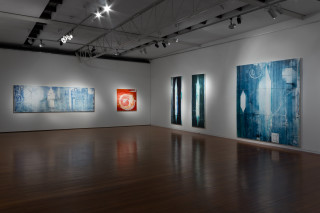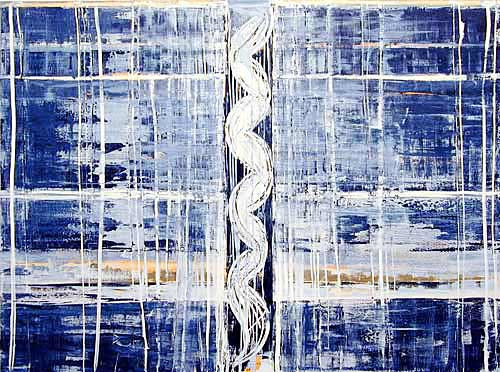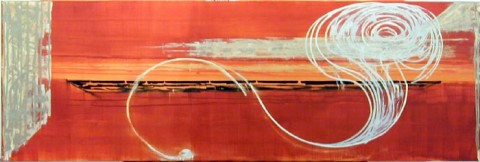Painting in a strange way is a type of soliloquy—communicating with yourself—oneself. There are times you do something on a surface that you recognise as something you have held or looked at—a seashell perhaps, or a softness of something—a bit of fruit—you're not actually going out and setting up a still-life situation—you're working through a process where you actually recognise something as it appears.
—John Firth-Smith
Exhibition Dates: 29 May – 5 July 2003
Let's talk about this notion of EQUIVALENTS. When did the idea occur to you?
In the whole process of painting a picture, you find yourself sitting back and looking at the work. As you apply the paint you're reminded of things.
In this present show, you seem to be conjuring in paint the equivalent of a place or an object or an emotion—a kind of parallel experience.
Some experiences are fleeting—amazing moments of happiness or sorrow—or amazing realisations, memories. A tragedy, a bushfire or an incredible dawn—a whale leaping out of the water—you're not there to whip out a camera—sometimes these experiences creep back years later—they suddenly reappear.
So you're having this constant conversation with the work?
Painting in a strange way is a type of soliloquy—communicating with yourself—oneself. There are times you do something on a surface that you recognise as something you have held or looked at—a seashell perhaps, or a softness of something—a bit of fruit—you're not actually going out and setting up a still-life situation—you're working through a process where you actually recognise something as it appears. It's a strange way of putting it all.
The whole point of making these paintings is to share something—I imagine.
Exactly—of course—you want the viewer to have a visual link—t's open to interpretation—like music. In the process of painting the picture, putting paint on and taking it off, working it up… the painting goes through a sequence. When you see film footage of clouds that are sped-up—suddenly the clouds are moving quickly over the landscape—t's almost as if you're painting like that. It's quite a good analogy that frantic thing of getting the painting to move—go thru' its processes, like that sped-up film of a cloud—otherwise it's rendering.
So what is it about painting?
Sometimes you want the painting to come up front like a brick wall—at other times you want to achieve atmosphere and distance—thick paint or thin paint. It's the limitation of paint that I find the biggest challenge. I find the complication of painting on a flat surface really difficult—trying to make a visual type of poetry. At times there is no joy really. The great effort is just relying on yourself—instinct and intuition and knowing—and that bit of information the gods have given you to pull these things off. I suppose the pleasure is forcing the work out of yourself—the exertion has a lot to do with it.
When do you think a painting is finished?
Well, funnily enough, after all this movement I've been talking about, really, a painting is finished when it gets to some static point, a kind of joggle fit, an equilibrium—you are exhausted by it, and it exhausts you. Inspiration is the catalyst—solitary working in the studio—groping with the ideas—the finished work represents a solution.
Tell me about your interest in photography.
I like taking photographs--it goes back to New York in 1981—images of snow and graffiti—but I don't use photographs as ideas for paintings. Recently, I took a photograph of some cracks in a roadway because they reminded me of one of my paintings—that's the reverse of that normal thing of working from a photograph.
You continue to find inspiration at Hill End.
Yes, the colour of the earth, the atmosphere--the unpredictable things you notice around you for the first time. I like the colour in my paintings to be as realistic as possible and, through the colour, suggest and evoke a reality. But location is only as important as the information found there—it's an ingredient. The studio is where it happens.
VOICE FROM NEXT ROOM: Anyone like a cup of tea?
Gavin Wilson and John Firth-Smith in conversation
Abercrombie Street Studio, Chippendale
31st March 2003
 John Firth-Smith
John Firth-Smith
Roslyn Oxley9 Gallery, 2012
 John Firth-Smith
John Firth-Smith
Roslyn Oxley9 Gallery, 2009
 Group Show, STOLEN RITUAL
Group Show, STOLEN RITUAL
Roslyn Oxley9 Gallery, 2006-07
 John Firth-Smith
John Firth-Smith
Roslyn Oxley9 Gallery, 2005
 John Firth-Smith
John Firth-Smith
Roslyn Oxley9 Gallery, 2003
 Group Show, The First 20 Years
Group Show, The First 20 Years
Roslyn Oxley9 Gallery, 2002
 John Firth-Smith
John Firth-Smith
Roslyn Oxley9 Gallery, 2001
 Group Show, All Stars
Group Show, All Stars
Roslyn Oxley9 Gallery, 2000
John Firth-Smith John Firth-Smith: A Voyage that Never Ends
Roslyn Oxley9 Gallery, 1999
 John Firth-Smith
John Firth-Smith
Roslyn Oxley9 Gallery, 1998
 John Firth-Smith
John Firth-Smith
Roslyn Oxley9 Gallery, 1996
 Group Show, Stockroom
Group Show, Stockroom
Roslyn Oxley9 Gallery, 1995
 John Firth-Smith
John Firth-Smith
Roslyn Oxley9 Gallery, 1993
 John Firth-Smith Work on paper from the last ten years
John Firth-Smith Work on paper from the last ten years
Roslyn Oxley9 Gallery, 1992
 Group Show, Christmas show
Group Show, Christmas show
Roslyn Oxley9 Gallery, 1991
John Firth-Smith
Roslyn Oxley9 Gallery, 1990
 John Firth-Smith
John Firth-Smith
Roslyn Oxley9 Gallery, 1988
John Firth-Smith Bottle and boat
Roslyn Oxley9 Gallery, 1983





















